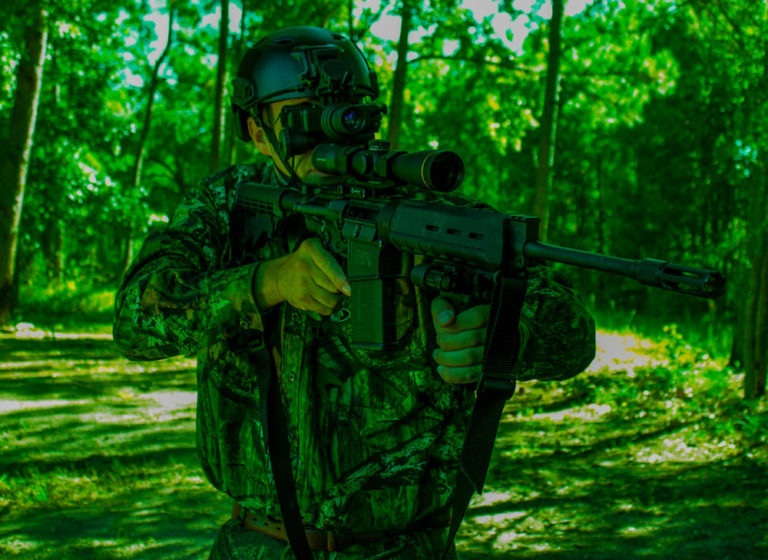
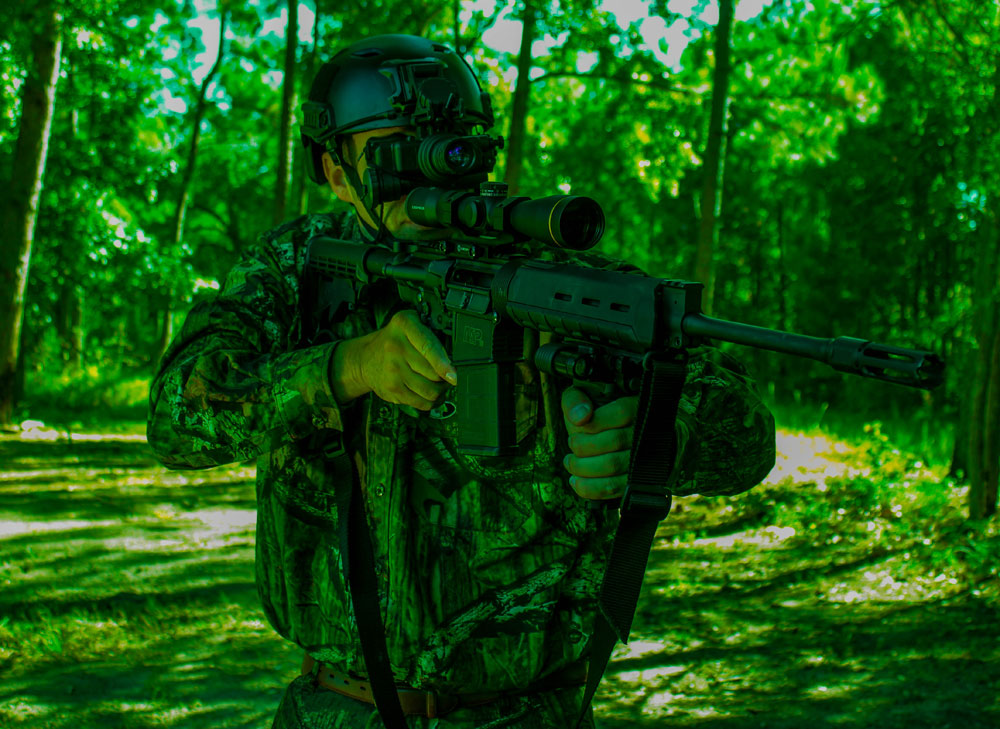 New technology in the field of thermal imaging and night vision equipment helps bring cutting-edge, user-friendly technology to shooters and hunters.
New technology in the field of thermal imaging and night vision equipment helps bring cutting-edge, user-friendly technology to shooters and hunters.
The east Texas night was inky black and the only sound I could hear—besides the occasional whine of a mosquito hovering around my exposed mouth and ears—was the steady sloshing and squealing of a sounder of perhaps 50 hogs as they lay waste to a rice field a quarter-mile away. Feral hogs had destroyed hundreds of acres of rice in that area of eastern Texas, and some farmers had suffered a complete crop loss for the year thanks to the area’s abundant pig populations. To make matters worse, those hogs had learned to feed under the cover of darkness and come to associate spotlights with gunfire. Turn on a any light and you might get a shot at a single pig before the sounder escaped from the flooded rice fields over the levies and back into the thick thorns that protected them from the midday sun.
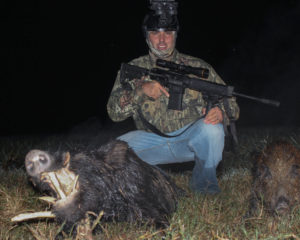 A group of eight of us walked down the levy closest to the farmer’s barn, ARs slung across our chests. The whole world was an odd shade of shimmering green as our night vision goggles picked up infrared light invisible to the naked eye. If you’ve never used night vision goggles before, it’s rather like looking through a paper towel roll, and field of view is very limited. The thorn thickets to our right were punctuated with oval tunnels that had been cut into the brush by the hogs as they made their way to the rice fields for their nightly raids. There were several large openings in the brush, and we had been warned before the operation began that the pigs would charge toward those openings when the shooting started and would run directly into or over us as they escaped. This offensive mission could, at a moment’s notice, turn into a defensive shoot.
A group of eight of us walked down the levy closest to the farmer’s barn, ARs slung across our chests. The whole world was an odd shade of shimmering green as our night vision goggles picked up infrared light invisible to the naked eye. If you’ve never used night vision goggles before, it’s rather like looking through a paper towel roll, and field of view is very limited. The thorn thickets to our right were punctuated with oval tunnels that had been cut into the brush by the hogs as they made their way to the rice fields for their nightly raids. There were several large openings in the brush, and we had been warned before the operation began that the pigs would charge toward those openings when the shooting started and would run directly into or over us as they escaped. This offensive mission could, at a moment’s notice, turn into a defensive shoot.
The black bodies of the hogs rose above the shallow water, and we each picked a pig as we spread out shoulder-to-shoulder down the levy. I turned on my Crimson Trace infrared sight and steadied the Smith & Wesson M&P10 on my shoulder, watching the glowing green dot settle on the junction of a boar’s neck and shoulders 50 yards away. The order came to fire, and I pressed the trigger.
Over the course of the next 30 seconds, nearly a hundred hogs rushed out of that water as 7.62 and 5.56 bullets whistled through the night. This was not a hunt but rather an eradication effort, and as such, every pig that appeared in your lane needed to be fired upon. Farther down the line, a sow made it to the levy and frighteningly close to one of our shooters before his M&P15 clapped and dropped the pig already halfway up the levy and perhaps 10 feet away from his position. As the roll of gunfire continued, pigs either fell in the field or cleared the levy on the far side, vanishing into the night.
Many people, including shooters and hunters, view night vision and thermal imaging equipment as the type of high-tech gear that is unattainable by anyone that isn’t in the military or law enforcement. In truth, however, technology companies have made these items increasingly user-friendly and more affordable than ever, and you’ll quickly find that night vision and thermal equipment serves a variety of uses from scouting and hunting to personal and home defense.
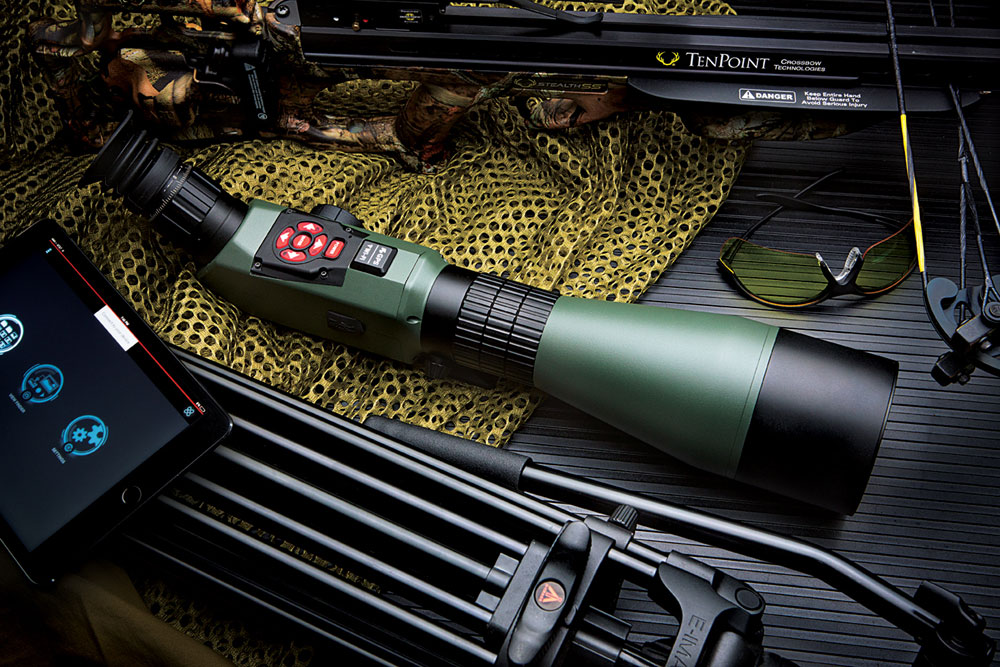 Night Vision Gear
Night Vision Gear
The human eye is poorly designed for seeing in near total darkness. For one thing, we don’t have as many rods (the element in your eye responsible for low-light vision) as other mammals like deer and cats. We also lack a tapetum, that reflective layer that channels light photons into our retina. If you shine a flashlight into the eyes of a raccoon, dog, bear or other animal at night, you’ll see the familiar “eye shine,” which is actually light reflecting on the tapetum inside the eye of those animals.
Humans need help to see at night, and that help comes via night vision equipment. More specifically, the electricity that the night vision equipment uses to maximize all available light so that our eye can function in near total darkness. Light enters the front of night vision equipment and strikes a photocathode that converts the photons to electrons. A photomultiplier amplifies the number of electrons, and those electrons hit a phosphor screen, which causes a flash of light. That multiplied light is visible to our eye.
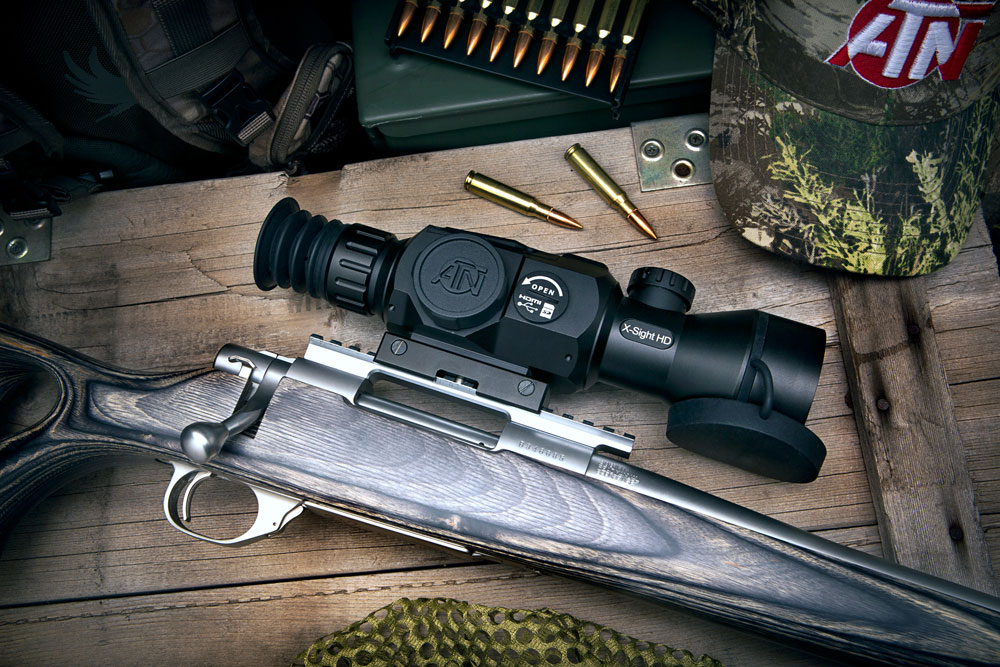 Night vision technology can be incorporated into goggles as well as scopes. ATN is one of the leaders in night vision technology and offers a wide selection of goggles similar to the style we used in Texas for our hog eradication. But, increasingly, night vision equipment is being mounted directly on firearms thanks to advancements in technology that make this equipment lighter and more durable than ever before. An example of that is the new ATN X-Sight II, which is considered a “Smart HD” optic with an Obsidian II Core that is capable of being used in daylight, darkness, and can record still and video imagery.
Night vision technology can be incorporated into goggles as well as scopes. ATN is one of the leaders in night vision technology and offers a wide selection of goggles similar to the style we used in Texas for our hog eradication. But, increasingly, night vision equipment is being mounted directly on firearms thanks to advancements in technology that make this equipment lighter and more durable than ever before. An example of that is the new ATN X-Sight II, which is considered a “Smart HD” optic with an Obsidian II Core that is capable of being used in daylight, darkness, and can record still and video imagery.
 That’s a lot of technology in one optics package, and that level of versatility makes lightweight rifle-mounted optics a great option for anyone who wants to shoot or hunt in both daylight and darkness. Mount this optic on your favorite .243 or .25-06 rifle and you’ve got a deer and antelope gun that can switch to night vision mode for hunting hogs and predators at night.
That’s a lot of technology in one optics package, and that level of versatility makes lightweight rifle-mounted optics a great option for anyone who wants to shoot or hunt in both daylight and darkness. Mount this optic on your favorite .243 or .25-06 rifle and you’ve got a deer and antelope gun that can switch to night vision mode for hunting hogs and predators at night.
ATN also offers firmware that can update existing X-Sights to the latest version, one of the great advantages of optics with onboard computers. There’s a 3-14x X-Sight HD that has an MSRP of $599. If you plan to shoot at extreme ranges, upgrading to the 5-20x version will cost an additional hundred bucks. This year, ATN is also launching a new smart spotting scope, the X-Spotter HD 20-80x, which offers day and night vision capabilities and video and still photo capture. The X-Spotter is loaded with high-tech features and blends high-magnification spotting with night vision capabilities. MSRP is $1,299.
If you have night vision equipment, you can pair your rifle with an infrared sight such as Crimson Trace’s MVF-515 vertical foregrip with infrared module. Because night vision goggles use infrared light, which is invisible to the human eye, an infrared sight system can’t be seen. In our case, we could turn on our infrared lasers and use them as sights that didn’t alert the hogs to our presence the way visible white light would. Also nice, the vertical foregrip allows you to control the light without removing your hand from the trigger. In addition to the infrared light, there was a white LED option for traveling to and from the vehicle without goggles. The MVF-515 with infrared module will carry a cost of $599.
 Thermal Imaging
Thermal Imaging
Thermal imaging equipment utilizes a detector array that picks up a thermogram (the heat produced by an object), and that thermogram is then translated into electrical impulses. These impulses are in turn translated to a display that shows our eye the heat signature of an object in our field of view. Every living creature gives off a heat signature, a byproduct of the metabolic reactions occurring within the body. In its infancy, thermal imaging was a relatively crude science, but modern thermal imaging equipment is extraordinarily sophisticated and detailed. It’s used by the military and law enforcement. In one case of a shooting in California, the suspect was trailed to his hiding place in a crowded subdivision (and quickly apprehended) without incident, and the gun he’d used and discarded in a bush as he ran from the crime scene was also rapidly recovered because it too left a heat signature behind. The equipment used in that apprehension came from thermal industry leader FLIR, which is based in Oregon.
While touring the facility I was allowed to play with some of the thermal imaging equipment that was available to the civilian market, and I couldn’t believe how clear and precise the images really were.
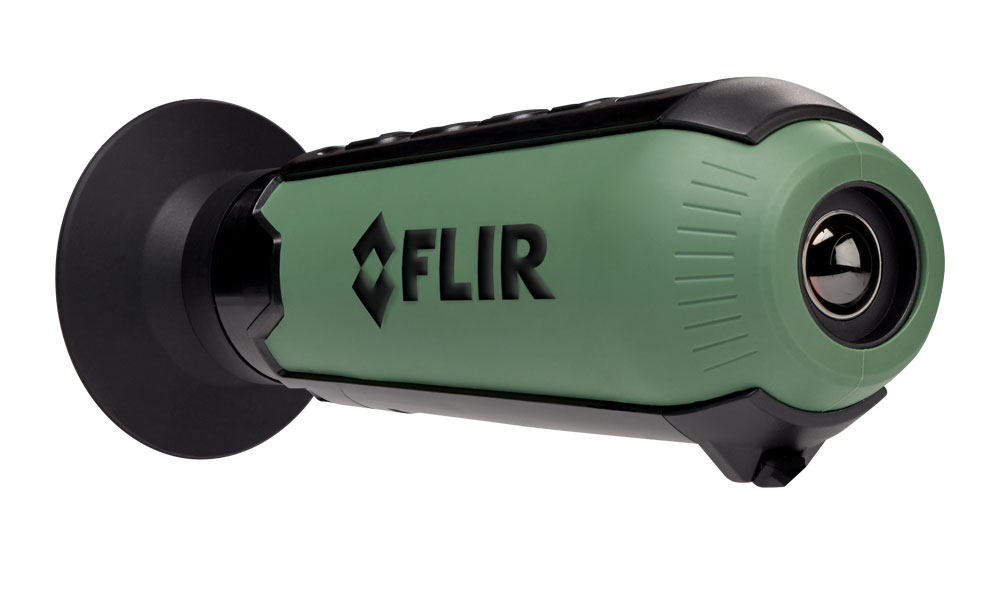 The FLIR Scout that I used was so sensitive that I could point it out the window in the parking lot and determine how recently a car had been parked in each parking spot; in spaces where cars had just left, there was a dark heat signature indicating a low temperature because the rays of the sun hadn’t reached the asphalt for quite some time. Likewise, I could place my hand on the wall and the heat signature remained for several minutes. That level of refinement is amazing—and that’s only the tip of FLIR’s thermal technology iceberg.
The FLIR Scout that I used was so sensitive that I could point it out the window in the parking lot and determine how recently a car had been parked in each parking spot; in spaces where cars had just left, there was a dark heat signature indicating a low temperature because the rays of the sun hadn’t reached the asphalt for quite some time. Likewise, I could place my hand on the wall and the heat signature remained for several minutes. That level of refinement is amazing—and that’s only the tip of FLIR’s thermal technology iceberg.
You may not have the need for a helicopter-mounted thermal imaging device, but almost everyone could benefit from owning a handheld thermal vision monocular. In 2016, FLIR launched its first pocket-sized (6 inches long and weighing just 6 ounces) monocular, the Scout TK, with thermal imaging capabilities and video and photo capture. In the past, high-quality thermal monoculars cost roughly $3,500, which placed them squarely out of the price range of a large portion of the hunting and shooting public. But the new Scout TK costs under $600, which is an outstanding price for the technology built into this pocket-sized thermal imaging device. Thermals are valuable for scouting game, but their worth extends far beyond that. I live in a very remote area far from the nearest town, and a FLIR is invaluable for personal protection. If I hear something go bump in the darkness outside I don’t need to turn on the lights; all I need to do is scan the landscape with a FLIR, and I immediately know if there is anything (or anyone) lurking in the shadows.
Editor's Note: This article is an excerpt from the August 2016 issue of Gun Digest the Magazine.









